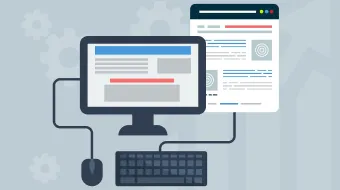Website security. Tips for protecting against malicious attacks.

Website security is currently a rather serious task for both website owners and developers. As the popularity of the World Wide Web has grown, its use has expanded significantly. In addition to searching for information, it is also used for communication between people, shopping, entertainment, research, and much more.
Vulnerability scans help to prevent the spread of malware and spam, which helps to protect users from negative impact.
Vulnerability scans help to prevent the spread of malware and spam, which helps to protect users from negative impact.
At the same time, it is important to understand that no one is safe from the threat of hacking: from large international resources to small local blogs. This leads to the need to take certain measures to ensure the protection of both your personal data and confidential information, the circulation of which is necessary for the normal functioning of the service.
Attackers have many ways of hacking websites to place malware on them, which is necessary for stealing confidential data or destroying information important for the site's functioning. In the following, we will analyse the main weaknesses and methods of their elimination as part of resource monitoring.
Why is it important to check website security?
Many users believe that their web resource is so small that no one will even try to hack it. What's the point if there are bigger fish to fry? However, this opinion is a mistake, and a very dangerous one at that.
An example of this is WordPress statistics, which revealed a high level of threat to bloggers. Due to the fact that many website owners did not pay attention to providing up-to-date security, more than seventy percent of resources were at risk of hacking. And we're not talking about trivial issues that can be solved by simply changing the password. The level of threats is much higher and can cause irreparable damage to the portal infrastructure and its direct users.
The most significant dangers are as follows:
- Injecting malicious code into the body of a website that covertly infects the devices of software users. It is often extremely difficult to find and remove it after it has been introduced.
- Damaging critical pages or replacing them with illegal websites with prohibited content.
- Loss of materials published on a web portal.
- Theft of confidential information of the owner and/or users of a web resource for the purpose of unauthorised use or resale. Most often, this concerns payment data from bank cards, logins, passwords and passport data required for a number of transactions.
- Gaining access to other websites located on the same physical server.
- Blocking a website in Google's SEO systems if malware is detected in the code. This leads to a significant decrease in traffic passing through the portal, as well as a drop in the number of unique visitors.
- Changing administrator data, which makes it impossible to manage and edit resources
The damage can be particularly serious if an online store comes under attack. It doesn't matter how large it is. The fact is that the vast majority of hacker attacks are automated and are applied en masse to all resources in case of detection of weaknesses in them. For this reason, website security systems need to be regularly updated and monitored.
The main reasons for successful hacks
From the above, we can understand that hacking as a phenomenon has become quite widespread. However, another question remains: what techniques do they use most often?
Anyone who has ever dealt with website development realises how complicated this process is. Each aspect is worked out over many days and weeks by specialists who have extensive knowledge of programming and server software. When it comes to a large resource with a large number of specialists, this approach allows you to ensure a high level of security without significant additional effort. However, the situation changes when it comes to small websites, which are sometimes managed by just one person.
Quite often, the security of website data is compromised due to the carelessness of administrators. In particular, we are talking about the use of easy-to-guess logins/passwords that can be easily guessed. In fact, this is the simplest and most common form of hacking. However, given that it works, it has become widespread. According to WordPress statistics, more than fifty percent of all website owners use the standard admin login for administrator access, which solves half of the hacker's problem. And the use of a simple password makes access to the account almost free.
Another massive ‘disease’ that provides unimpeded access to the website for attackers is the lack of updates of connected plugins to the current version. This allows you to exploit old known vulnerabilities in the code, while the current revisions have eliminated them.
There are many more complex and sophisticated methods of hacking Internet portals, but practice shows that most hacker attacks are carried out by selecting a password and using outdated software.
How to perform a website security check?
In order to identify vulnerabilities and eliminate them, it is necessary to use a comprehensive analytical approach that allows you to use various tools to check the front-end and back-end components for hacker loopholes, as well as to make sure that personal data is safe for access and not compromised.
Using an online scanner
You can check the security of online websites using special virtual scanners that analyse the website remotely for the most serious vulnerabilities in the system. Among the most significant advantages of this methodology are the absence of the need to install additional software, as well as the minimum amount of time spent on the scan.
At the moment, there are dozens of scanners with high performance indicators available in the public domain. The easiest to use is Sucuri SiteCheck. This tool is an attractive option because it allows you not only to detect problems but also to fix them immediately.
In addition, this tool allows you to check the resource against blocking lists and remove it from them after all the identified issues have been fixed. This makes the use of online scanners the best solution to start improving the security of a web portal.
Detect unauthorised changes
If you suspect that a website contains malware, or even know for sure that it does, it can be quite difficult to identify the source of the infection. There are several nuances that you should check first.
They are clear indicators of third-party interference:
- The appearance of links that were not added by the administrator;
- Changes in the content of pages or the appearance of new branches in the site directory;
- ‘Spontaneous’ change of settings;
- Sudden appearance of a new moderator or administrator without your knowledge;
- Changes in the number and content of plugins and/or themes.
It is quite common to make changes at the level of the site code. If you have an understanding of coding, you can manually make changes to eliminate the harmful effects. However, before doing so, you should make a backup copy of all important files.
If you have access to the site via FTP, you can also sort by the date of changes and detect unauthorised changes to the site's code.
If the site is periodically infected for no apparent reason, the reason may lie in the server that hosts it.
Check for the latest updates
As mentioned earlier, out-of-date software used to run a web portal is one of the most common methods for hackers to gain access to administrative services for managing a resource. To ensure website security, it is extremely important to ensure that all updates are installed.
For WordPress users, this is not a big deal, since starting from version 5.5, all integrated components are updated automatically by the CMS.
Use strong logins and passwords
The most popular reason for successful account hacking is a weak password for the main account. With the help of brute force programs, this makes it possible to easily gain access to administrator rights and, as a result, the ability to make any changes to the site.
While a complex password can be difficult to remember, making access less convenient for the owner, restoring access after a hack is an even more inconvenient and time-consuming process that may not always be successful. Therefore, it is worth taking care of a sophisticated security system. If possible, it is also recommended to use two-step authentication.
As a rule, a password should consist of uppercase and lowercase letters, numbers, and symbols. The best option is to use a randomly generated combination that is not based on words or personal information. This makes access much more difficult for intruders.
Check your SSL certificate
An outdated SSL certificate is usually immediately apparent. Modern browsers instantly block access to a web service in case of data mismatch and display a warning about the certificate's expiration. In case of such an error, it is worth checking not only the validity of the key but also the support of the current version of the SSL/TLS protocol.
You can spot SSL mismatches in the address bar of your browser. If everything is fine, a grey padlock is displayed there. This is true for the vast majority of resources. If there are any inconsistencies, it turns red or is crossed out, which makes it clear to the user that there are problems. To get all the information about the verified SSL certificate, just double-click on the padlock icon.
Common vulnerabilities
In addition to the features described above, many WordPress sites have many other attack directions that seem completely harmless at first glance. However, in practice, they provide wide access to a large amount of information.
To block them, it is necessary to study in more detail the structure of a particular service and the capabilities of the CMS to ensure the safe operation of the web service.


